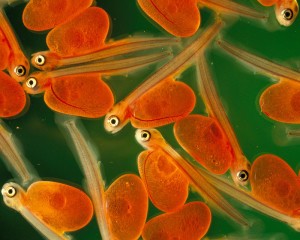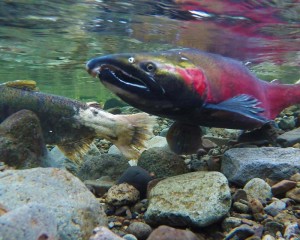
Spring 2016 Leaflet
WATER & WILDLIFE
Welcoming Home the Salmon

When salmon eggs hatch, the young fish, called alevins, remain attached to their yolk sacs for up to ten weeks. They are largely immobile and stay in their nests until their yolks are absorbed.
Walking along the sides of Squaw Creek in the California van Eck redwood forest this winter, we found a number of coho salmon nests and other welcome signs that this stream is home to these magnificent fish.
Each spring, coho salmon emerge from pea-sized eggs laid together in a nest, called a redd. Salmon are the most vulnerable at this stage. At first, these tiny hatchlings, or alevins, rely on food from their yolk sacs, which remain attached to their bodies for up to ten weeks. In addition, early spring temperature shifts can cause the fish to freeze and disturbances in their habitat can stir up too much silt or wash away gravel and protective structures.
To safeguard these tiny and growing salmon, Pacific Forest Trust is working to restore and protect their habitats.

Coho salmon are listed as threatened under both the California and federal Endangered Species Acts. Since we began restoring habitat for salmon in the van Eck forests, we have observed young coho salmon, redds (nests), and adults in the streams running through the property.
Each fall, three years after they left, salmon return to spawn in the clean waters of the van Eck forest. They leave the Pacific ocean and re-enter the Mad River just north of Arcata, California. They swim upstream, returning to the waterways in which they hatched. Within this working redwood forest, we have 200-foot wide buffers around all fish-bearing streams, in which we focus our activities on restoration, seeking to promote salmon habitat. We also collaborate with neighboring landowners to restore adjoining habitat degraded or lost through past management.
As a result, these riparian forests are beginning to recover their more natural structure and composition, shading and enriching the streams that flow through them. The waterways in and around these forests are also known to support Chinook and steelhead salmon as well as coastal cutthroat trout, which also benefit from these restoration efforts.
Working with the California Forest Improvement Program, we’re developing plans to restore more natural stream contours and reestablish pools and refuges for coho salmon. This will restore more natural function to the waterways impacted when the area was converted to pasture and a rail line put in, in the early 1900s. This is crucial for coho salmon recovery. It helps them when they are most vulnerable and allows them to grow big enough to make the journey to the sea and begin their upstream swim again.
Photo Credits:
- Newly Hatched Salmon Alevins by the U.S. Department of Agriculture, CC by 2.0
- Coho Spawning on the Salmon River by the Bureau of Land Management Oregon and Washington, CC by 2.0
